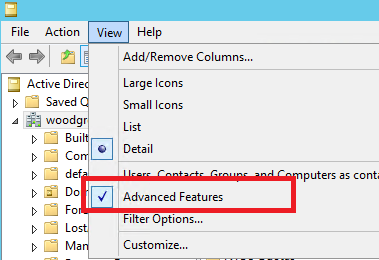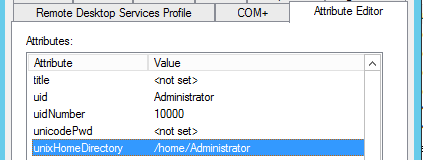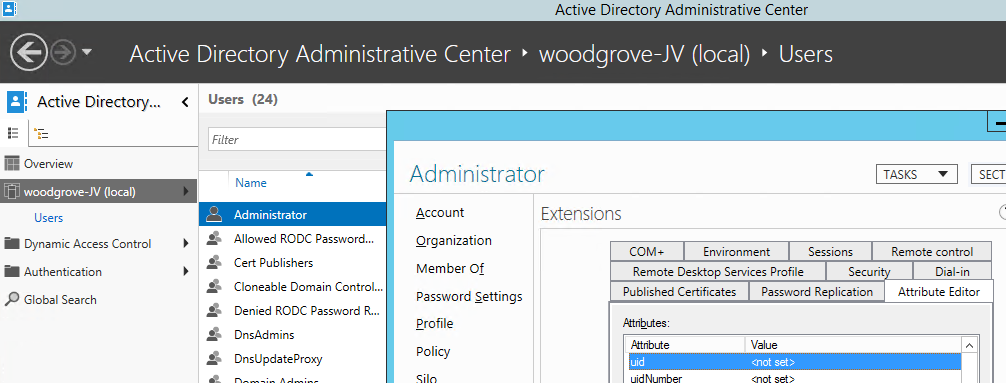Clarification regarding the status of Identity Management for Unix (IDMU) & NIS Server Role in Windows Server 2016 Technical Preview and beyond
Note: The original blog article has been updated to address a number of questions we received and to further clarify what has been removed and what remains. Due to the Active Directory Documentation Blog being retired in October 2015, the comments have been removed. Please post your questions/comments in the Directory Services TechNet Forum .
With Windows Server 2012 R2, Microsoft announced the deprecation of the Identity Management for Unix (IDMU) and NIS Server role which will not be included starting with Windows Server 2016 Technical Preview. This has been documented in a couple of places:
In this blog article we will go into further detail and answer questions on what this means to you when you are migrating/upgrading to Windows Server 2016 and are using Identity Management for Unix/NIS Server with Windows Server today.
Why did Microsoft remove IDMU/NIS Server role from Windows Server?
After carefully reviewing and considering the feature usage, industry trends, availability of native Active Directory options on Linux/Unix and security concerns of NIS in general, the decision was made to remove the functionality from Windows Server. We announced the deprecation in the development phase of Windows Server 2012 R2 and have removed it from Windows Server 2016.
What IDMU/NIS Server components are removed from Windows Server 2016?
IDMU/NIS Server has been removed, specifically the following components are no longer included with Windows Server 2016:
- Network Information Service (NIS) Windows Server role
- The Unix Attributes plug-in for the Active Directory Users and Computers Management Console (MMC) snap-in
Note: RFC2307 attributes (e.g. GID/UID etc.) in Active Directory continue to exist. See below for further details.
I am using Windows Server IDMU/NIS Server role today, what should I do?
We recommend to start planning for alternatives, for example: native LDAP, Samba Client, Kerberos or other non-Microsoft options. Existing Windows Server 2012 R2 or earlier deployments will continue to be supported in accordance with the Microsoft Support lifecycle.
What happens when I have the NIS Server Role installed and try to upgrade to Windows Server 2016?
If you try upgrade to Windows Server 2016 from a Windows Server that runs any of the Identity Management for Unix (IDMU) components, the upgrade will stop and you will be prompted to remove the IDMU components as explained in “Installing or removing Identity Management for UNIX by using a command line”.
Can I continue to use the GID/UID (RFC 2307) attributes I am using today with Active Directory after I upgrade to Windows Server 2016?
Active Directory does not remove the populated UID/GID Active Directory attributes during the upgrade to Windows Server 2016 from Windows Server 2012 R2. The attributes will remain part of your Active Directory setup. These attributes were introduced as part of RFC 2307 support that was added in Windows Server 2003 R2.
For example, you may require the RFC 2307 attributes in combination with Network File System (NFS) Server (which does not require NIS Server role to be installed on Windows Server) to map the identity.
How do I continue to edit the GID/UID RFC 2307 attributes now that the Unix Attributes Plug-in is no longer available for the Active Directory Users and Computers MMC snap-in?
There are a couple of ways to continue to administer the attributes:
1. Active Directory Users and Computers MMC snap-in
1. Open Active Directory Users and Computers.
2. From the dropdown menu, select View -> Advanced Features:
3. Open the properties of a User, Group or Computer Object
4. Navigate to “Attribute Editor” tab to edit the following attributes:
-
- uidNumber
- gidNumber
- Loginshell
- unixHomeDirectory
- MemberUid
- ipHostNumber
2. Active Directory Administrative Center
1. Open Active Directory Administrative Center
2. Navigate to a User, Group or Computer Object
3. Navigate to Extensions
4. Navigate to “Attribute Editor” tab to edit the following attributes:
-
- uidNumber
- gidNumber
- Loginshell
- unixHomeDirectory
- MemberUid
- ipHostNumber
3. Scripts (preferred method for bulk operations and automation)
· Using Active Directory PowerShell Cmdlet:
o Below is sample code to query/configure the various attributes
Import-Module ActiveDirectory
#To query Unix Properties of a User Object
$username = "guest"
Get-ADUser $username -Properties * | Select SamAccountName, msSFU30NisDomain,uidNumber, unixHomeDirectory, loginShell, gidnumber, @{Label='PrimaryGroupDN';Expression={(Get-ADGroup -Filter {GIDNUMBER -eq $_.gidnumber}).SamAccountName}}
#To query Unix Properties of a Group object
$groupname = "Unix Sample Group"
Get-ADGroup $groupname -Properties * | Select SamAccountName, msSFU30NisDomain,gidnumber, @{Label='Members';Expression={(Get-ADUser -Filter {GIDNUMBER -eq $_.gidnumber}).SamAccountName}}
#To query Unix Properties of a Computer Object
$computername = "server123"
Get-ADComputer $computername -Properties * | Select SamAccountName, msSFU30NisDomain,ipHostNumber, msSFU30Aliases
#Set unixHomeDirectory on a user (replace this with any of the attributes you’d like to set)
$username = "guest"
set-ADUser $username -Replace @{unixHomeDirectory="/usr/sbin/guest"}
o Below, is sample output from the sample code above
Sample output from the PowerShell Script:
SamAccountName : Guest
msSFU30NisDomain : woodgrove
uidNumber : 10001
unixHomeDirectory : /usr/sbin/guest
loginShell : /bin/sh
gidnumber : 10001
PrimaryGroupDN : Unix Sample Group
SamAccountName : Unix Sample Group
msSFU30NisDomain : woodgrove
gidnumber : 10001
Members : {Administrator, Guest}
SamAccountName : Server123
msSFU30NisDomain : woodgrove
ipHostNumber : {10.2.2.2}
msSFU30Aliases : {bla, unixtestclient}
· Using NFS PowerShell CmdLet Set-NfsMappedIdentity: Please see the following page for more information: Set-NfsMappedIdentity.
· Using VBScript: There is also a TechNet blog article from a while back that has some additional detail to configure and populate the attributes in Active Directory https://blogs.technet.com/b/dsix/archive/2009/04/16/integrating-unix-client-in-active-directory-using-ldap-part-i.aspx.
What Active Directory Attributes did the Unix Attribute tabs expose in the Active Directory Users and Computers MMC snap-in prior to Windows Server 2016?
The following Active Directory Attributes were configurable from the Unix Attributes tabs in Active Directory Users and Computers prior to Windows Server 2016. This table is provided as a reference and with Windows Server 2016 all of these attributes can be modified using the methods described as part of this blog article above:
| Dialog name | AD Attribute | RFC2307 attribute | Example | User object | Group object | Computer object |
| UID | uidNumber | X | 1000 | X | ||
| Login Shell | Loginshell | X | /bin/bash | X | ||
| Home Directory | unixHomeDirectory | X | /home/username | X | ||
| Primary Group name/GID | gidNumber | X | 10002 | X | X | |
| Members | MemberUid | X | Administrator | X | ||
| iphostnumber | ipHostNumber | X | 10.2.2.2 | X | ||
| NIS Domain | maSFU30NisDomain | “example” | X | X | X | |
| Members | msSFU30PosixMember | CN=Group,CN=Schema, CN=Configuration, DC=Woodgrove,DC=Local | X | |||
| Name | msSFU30Name | “Server123” or “Administrator” or “unix group” | X | X | X | |
| Computer Aliases | msSFU30Aliases | Alias1; alias2 | X |
Thank you for reading this article!
Note: Questions and comments are welcome. However, please DO NOT post a request for troubleshooting by using the comment tool at the end of this post. Instead, post a new thread in the Directory Services Technet forum. Thank you!
Comments
- Anonymous
January 01, 2003
We hear you, and thanks again for the feedback. The default schema is of course fully supported, and the UNIX attributes are included by default. We cannot say for sure what the default schema will include in future releases, but there are no plans to change the inclusion of the UNIX attributes.
To be more clear about this whole issue, IDMU will continue to be supported throughout the support lifecycle of Windows Server 2012 R2. But we want customers to be aware of the deprecation so they can make alternative plans before product support ends and avoid any kind of fire drill.
Justin [Active Directory Documentation Team] - Anonymous
January 01, 2003
Thanks for the feedback Justin and Lee. I am sharing your comments with the engineering team.
The schema is not touched, e.g. data that was added to AD will still be there and customers can still use the AD Users console with the plug-in installed to continue managing these identities from Windows Server 2012 R2.
As for rationale, the decision was made after reviewing customer data and available functionality. Given other alternatives available (native LDAP, Samba Client, Kerberos, or non-Microsoft options), the decision was made to stop investing in this specific feature.
Thanks,
Justin [Active Directory Documentation Team] - Anonymous
January 01, 2003
Hi David,
Thanks for asking. I'm told by the engineering team that the recommendation is to use native LDAP, Samba Client, Kerberos, or non-Microsoft options on Unix/Linux systems to integrate with Active Directory for password management. There are also third-party solutions but those are not tested by Microsoft so we don't make any specific recommendations about them.
Justin [Active Directory Documentation Team] - Anonymous
January 01, 2003
Jim Cottrell, thanks for the feedback. It has been shared with engineering team and they are investigating options. I will post any updates here.
CH Liu, I am not aware of any docs we have for RH integration. As far as I know, it's not something we test or have guidance for.
Thanks,
Justin [Active Directory Documentation Team] - Anonymous
January 26, 2015
Hello - What will be the supported method of integration with Unix/Linux on Server 2012 R2 in lieu of IDMU? - Anonymous
February 04, 2015
Uhhhh... what is the rationale for this? Are you aware that there are a LOT of large customers out there using AD for LDAP for UNIX identities? - Anonymous
February 04, 2015
The comment has been removed - Anonymous
February 04, 2015
This seems like a very disruptive unilateral decision which will impact greatly the acceptance of Active Directory as the source of truth directory service in an organisation - Anonymous
February 05, 2015
Thanks. As far as sheer numbers go, I'm sure it's not a large % but there are some very large customers (like, Microsoft large) using AD for UNIX LDAP. So it's good they won't have to back out of the AD setup. I assume MS will still fully support the schema, too.
As far as extending the schema, does Win2k12R2 and beyond add the UNIX attributes by default? Or do they need to be built out manually?
As I'm sure you know, AD is pretty ideal for LDAP for a variety of reasons, so I'd hate to see MS abandon this. - Anonymous
April 01, 2015
Is there going to be more detail of exactly what services will no longer be in available? I understand an LDAP + KRB5 configuration should still work post 2012 R2 but how will it be managed? Will the attributes need to be updated via PowerShell / ADSI Editor? Is the "Unix Attribute" tab actually going away?
We recently decided to utilize AD as our single source of authorization and authentication source. However that may have to be recant if this decision will impact our daily operations.
Over the past few years we've closed on the % of Windows vs Linux and decisions like this are painful. - Anonymous
April 17, 2015
The comment has been removed - Anonymous
April 30, 2015
We are deploying new 2012 AD now and also wanted to integrate Redhat Linux 6 with 2012 AD. Is there any document we can follow from Microsoft side? We have steps and procedure to follow on Redhat end of configuration. However, I can not find any technical article/document regrading 2012 AD change for this integration. I would appreciate it if someone can suggest the right technical article/doc on Windows 2012 AD side of configuration since IMU is being deprecated. - Anonymous
May 15, 2015
The comment has been removed - Anonymous
June 17, 2015
This is a VERY bad idea. The UNIX attributes are widely used by shops moving from OpenLDAP to AD. Im currently moving a very forward thinking company from OpenLDAP to AD and I NEED the Unix attributes tab.
Microsoft should understand the many application of these attributes and their value in the Enterprise.
Best, John - Anonymous
July 01, 2015
So does Microsoft want everyone to use another product?
We have to start looking for another solution due to this being removed from AD.


